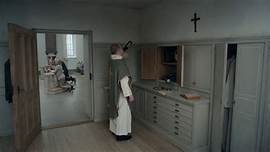In one of the series of vignettes that make up Roy Andersson’s ABOUT ENDLESSNESS, we find a city café where the patrons sit in carefully constructed isolation among one another, in the foreground, a dentist who we know from the previous vignette, is in a bad mood and plagued with problems. Snow falls. Christmas carols play. Otherwise, there is silence and then, from the back a man asks no one in particular, “Isn’t it fantastic?” After a beat, the reply, “What?” “Everything.” Silence again. It is almost at the end of Mr. Andersson’s latest contemplation of existence, and sums up what we have seen, catching both the absurdity of the question and its answer, as well as its ironic truth in them both.
In the vignettes, most random, some interrelated, there is the banality, drama, and excruciating comedy of la vie quotidian. A woman breaks the heel of her shoe and discards the pair. Another tends to a potted plant, catching the eye of a young man passing by who stops to watch. He is, we are informed by the intermittent narrator, a young man who has not found love. Elsewhere, a couple sitting all but motionless on opposite sides of a very small room, discuss the first law of thermodynamics, the one about everything being energy that is neither created nor destroyed, imbuing immortality of a sort. Whereupon the woman opines that she’d like to come back as a tomato rather than a potato. The mysteries of the universe juxtaposed with musings that obviate the wonder of it all.

Martin Serner
And so it proceeds, in colorless shades of a Swedish winter, even in scenes set in the summer. Those carefully composed vignettes in which the inherent isolation of the self is displayed in long, fixed-point, single takes and the way that the all but stationary actors fail to interact on a visceral level, even when blows are exchanged. The impersonality of the interactions is emotionally oppressive, while also rife with dark humor. Hence, a crisis of faith that conflicts with a bus schedule has the same resonance as a man pleading, persistently if passively, for his life as a firing squad goes about its business without responding to him. The scene of a busload of people failing to register a weeping man turns to a discussion of a person’s right to be said, and where he should indulge in his despair. There is compelling beauty in these visuals, as well as a persistent coldness, even in scenes of magical realism in which a man and woman echo a Chagall painting of lovers floating in a cloud over a city in ruins.
There may be no narrative in the traditional sense, but there is a cohesiveness to the cinematic journey through the spectrum of humankind’s emotions. For that reason, the action, unmoored from traditional storytelling, allows us to have a deeply experiential journey with these characters, making even those who appear for only minute or so indelible, and us curious to know more. And here is why the film is so potent. With this approach, Mr. Andersson has slyly seduced us into filling in the blanks he has created, making us part of the process while also pondering eternity. He has given us the cinematic equivalent of a Rorschach test, in which our reactions to what is shown says as much about us as it does his vision.
Your Thoughts?